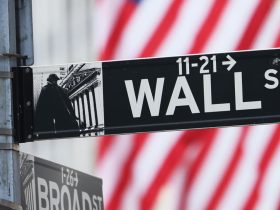The recent surge in bond yields is a big shift in markets. But there are glimmers of good news.
For one, a slight pullback in bond yields on Wednesday was able to lift stocks after they’ve been hammered for the past few weeks. It raises hopes that maybe bond traders think enough is enough now, and that Treasuries are oversold.
The idea that things may have already gone too far is evident in the drop in oil prices. The U.S. benchmark dropped 5.6% on Wednesday on concerns that higher borrowing costs will hold back the economy, dampening demand for energy.
But there are reasons to be cheerful. The spike in bond yields to 16-year highs has been concentrated on the longer end of the curve—10 and 30-year bonds. Short-term yields have stabilized—the yield on the two-year Treasury note has only risen to 5.05% from 5.03% a month ago. Three months ago, the two-year yield was at 4.96%.
This suggests bond investors haven’t changed expectations for Federal Reserve interest rates in the short term. It really is a case of seeing rates higher in the more distant future than previously imagined, while expectations for the peak of Fed rates haven’t changed much.
What’s more, the steepening of the curve at the longer end is doing the Fed’s job for it. Ironically, the recent tightening of financial conditions that higher bond yields represent may give the Fed room to keep its benchmark lower than it would otherwise need to.
To be sure, the bond yield spike still hurts. The fact that bonds and stocks are falling at the same time, as they did for much of 2022, suggests there are few havens. But if you squint hard enough, there may be light at the end of the tunnel.
—Brian Swint
*** Join Barron’s senior managing editor Lauren R. Rublin and healthcare industry reporter Josh Nathan-Kazis today at noon when they discuss recent developments in biotech, pharma, and other segments of the healthcare market, and the outlook for healthcare companies and stocks. Sign up here.
***
Sam Bankman-Fried’s Fraud Trial Starts in Landmark Case
Lawyers at the fraud trial of former FTX CEO Sam Bankman-Fried gave differing accounts of what transpired at the defunct crypto exchange and related firm Alameda Research. Prosecutors said Bankman-Fried took customer money to build a life “built on lies,” while the defense said he didn’t intend to defraud anyone.
- Defense attorney Mark Cohen described the 31-year-old as a “math nerd” who set out to launch a business in good faith. He added that Bankman-Fried took what he thought were reasonable actions when lenders recalled loans to Alameda, but “some things were overlooked.”
- Bankman-Fried has been indicted on seven counts including wire fraud and conspiracy to commit money laundering. Five of the charges carry a maximum prison term of 20 years. Bankman-Fried has pleaded not guilty.
- Four top company executives have pleaded guilty to various charges. Former Alameda Research CEO Caroline Ellison, FTX co-founder Gary Wang, and former head of engineering Nishad Singh have agreed to testify during the trial.
- Assistant U.S. Attorney Thane Rehn said Bankman-Fried “promised” customers they could withdraw their deposits to FTX whenever they wanted. But billions of dollars of customer money went instead to an Alameda-controlled bank account, he said. Rein said Bankman-Fried used Alameda to steal more than $10 billion from FTX.
What’s Next: FTX software developer and Bankman-Fried’s college friend Adam Yedidia, who said he quit his job after discovering that Alameda had been paying back creditors with FTX customer deposits, will continue testifying today, The Wall Street Journal reported. The trial could last six weeks.
—Janet H. Cho
***
Rivian Disappoints With Guidance and Fresh Fund Raise
Rivian issued disappointing guidance late Wednesday and announced plans to raise more funds just days after the electric truck maker said it had delivered more units than expected in the third quarter. The stock was falling in early premarket trading.
- After the market had closed, Rivian said sales in the current quarter would be slightly lower than analysts estimated. It also said it would issue $1.5 billion in convertible notes—debt that can be turned into shares, which has the potential to dilute the holdings of current owners.
- Rivian’s vehicles are tempting for American buyers of electric-powered pickup trucks that handle like sports cars. But they sell at about $80,000 on average, and developing them is expensive. The company is burning through cash—it sold trucks at an average loss of $33,000 in the second quarter.
- The stock has had some big swings. It’s up more than 25% since Jan. 1, but is still 36% lower than 12 months ago. It has depleted about half of its $18 billion cash pile. Shares are down some 70% since it raised $12 billion in a 2021 initial public offering.
What’s Next: The challenge for the company now is to reduce costs and streamline production. Rivian says the current losses are necessary to get the company growing. It plans to make a profit on its vehicles in 2024.
—Brian Swint
***
Biden Forgives Another $9 Billion in Federal Student Debts
President Joe Biden approved another $9 billion of student loan debt relief, extending loan forgiveness to 125,000 borrowers just as federal student loan payments resume this month. The move goes through existing channels after the Supreme Court rejected Biden’s broad loan-forgiveness program in June.
- This time eligibility includes borrowers under the Public Service Loan Forgiveness program, borrowers who made payments for 20 years or more in an income-driven repayment plan, and borrowers with disabilities who have been approved for discharge by Social Security.
- Biden aims to bring debt relief to as many student borrowers as possible. So far the administration has canceled $127 billion in debt for nearly 3.6 million borrowers, though his broader program struck down by the Supreme Court could have aided 40 million borrowers.
- That broader effort would have canceled up to $20,000 in debt for those earning less than $125,000 a year. Since then, the White House has canceled debt in longstanding programs that have been plagued with problems and that didn’t provide the relief they were supposed to provide.
- In July, 800,000 lower-income borrowers had their remaining balances wiped out as part of a one-time adjustment to loan-repayment plans. Republicans say the administration lacks the legal authority to make broad-based adjustments.
What’s Next: The Education Department proposed forgiving additional debt under the authority of the Higher Education Act, through a rule-making process that may not be finalized until 2025. Student financial aid expert Mark Kantrowitz said it could face legal challenges.
—Elizabeth O’Brien and Janet H. Cho
***
Kaiser Permanente Workers Officially Join Season of Labor Activism
Nearly 75,000 healthcare workers at Kaiser Permanente began a three-day strike early Wednesday after failing to make progress in contract negotiations with the nonprofit healthcare provider. The healthcare industry is battling burnout from the Covid-19 pandemic, understaffing, and heavy workloads.
- Unions representing Kaiser workers want a $25 hourly minimum wage and annual pay increases. Kaiser has proposed minimum hourly wages of between $21 and $23 next year depending on the location. It also plans to hire 10,000 by the end of October after hiring 51,000 last year.
-
It’s the latest strike in a season of labor activism. Negotiations between United Auto Workers and
Ford Motor
have moved forward, narrowing their differences on pay increases, Reuters reported. UAW President Shawn Fain plans to update 150,000 union members on Friday. - The number of workers participating in a strike reached 412,000 this week, according to the Bureau of Labor Statistics and Barron’s calculations, the highest since 2019. This year’s walkouts are mostly from private-sector workers.
- This year’s strikes are also lasting longer. More than eight million workdays have been idled due to strikes so far in 2023, the highest since the turn of the century. In 2019, only 3.2 million workdays were disrupted.
What’s Next: The California legislature has sent Gov. Gavin Newsom a bill that would increase the minimum wage for the state’s 455,000 healthcare workers to $25 an hour over the next decade. The governor has until Oct. 14 to decide whether to sign or veto it.
—Liz Moyer and Evie Liu
***
As Treasury Yields Rise, It’s Time to Brace for 8% Mortgages
Now that Treasury yields have been rising, the reality of an 8% mortgage rate looks increasingly likely. Last week’s average 30-year fixed-rate mortgage loan was already the highest since 2000, according to Freddie Mac. The latest rate data come out later today.
- Mortgage rates measured weekly by Freddie Mac have increased by nearly a full percentage point since the end of 2022, especially in the late summer and early fall. The 10-year Treasury yield reached its highest level since 2007 earlier this week, a hint of things to come.
- Home loan applications sank to their lowest level since the mid-1990slast week as mortgage rates climbed, according to Mortgage Bankers Association data. Mortgage rates have risen for four straight weeks.
- An increase to 8% would drive rates to their highest level since August 2000, according to Freddie Mac data. Such a rate is high compared with recent years, but it is far from staggering historically. Mortgage rates measured by Freddie Mac reached as high as 18.6% in 1981.
- Prices for existing homes nationally are once again approaching the all-time highs they notched in 2022 as homeowners who locked in historically low rates in the Covid-19 pandemic’s early years have little incentive to swap their 3% rates for a higher-rate loan.
What’s Next: National Association of Realtors chief economist Lawrence Yun said every one percentage point increase in mortgage rates prices an additional three million potential buyers out of the housing market. That could mean 250,000 to 300,000 fewer home sales on an annualized basis.
—Shaina Mishkin and Liz Moyer
***
The latest El Niño weather pattern could also mean a wetter-than-usual season for Florida and normal-to-above normal snowfall for the Northeast this winter, while the Mountain West could start out with lower than normal precipitation.
The latest predictions from the National Oceanic and Atmospheric Administration could mean short-term relief for Americans who struggled through summer’s heat extremes, but also pose a downside for retailers banking on a flurry of winter-clothing and supplies purchases. The added precipitation, however, points to plenty of snowpack for skiing and snowboarding at popular sites.
For more, read here.
—Rachel Koning Beals
***
—Newsletter edited by Liz Moyer, Patrick O’Donnell, Rupert Steiner
Read the full article here













Leave a Reply